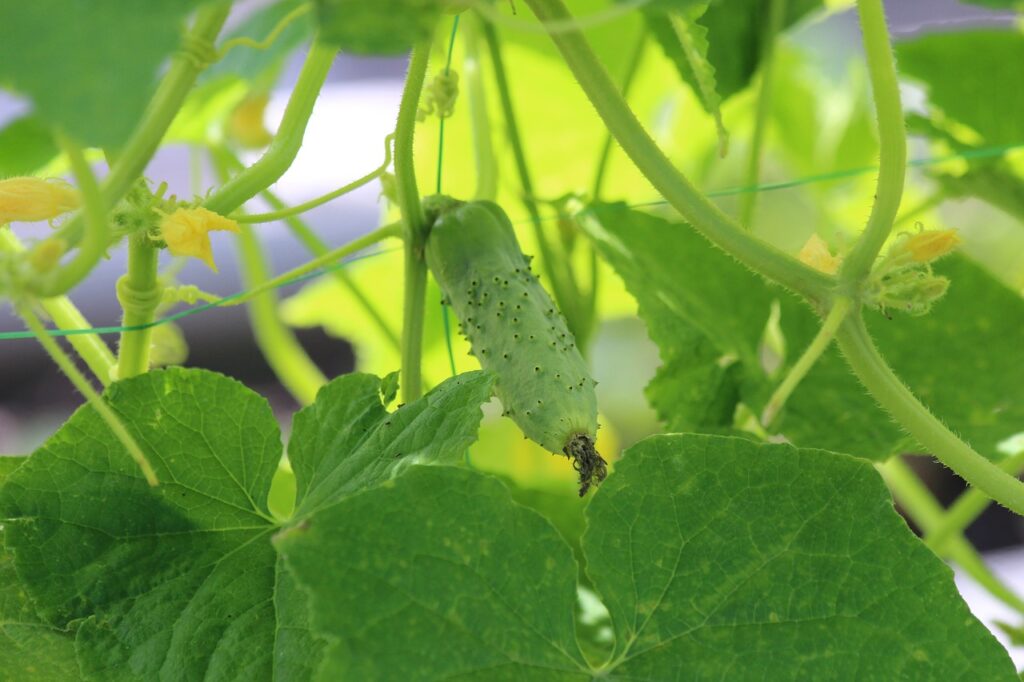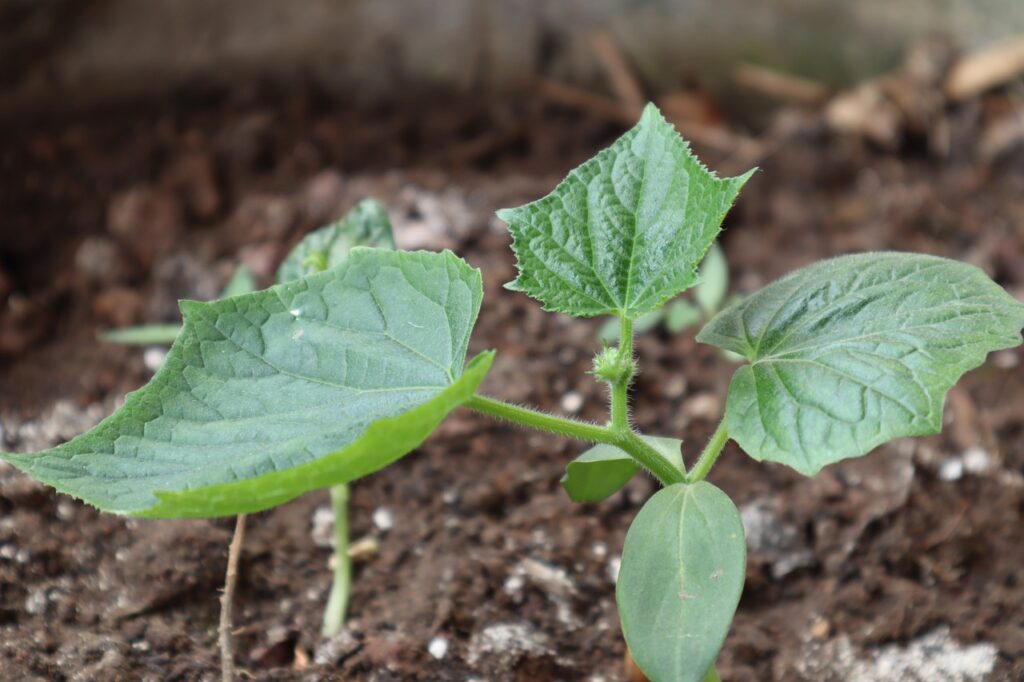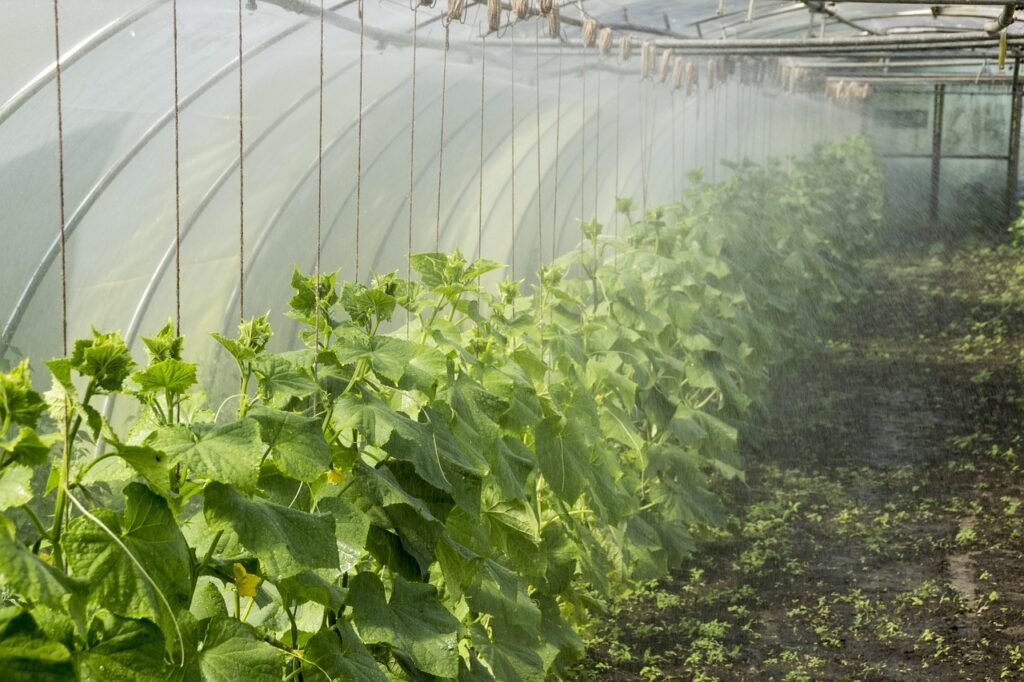Cucumbers are one of those crops that you really ought to be growing on your market farm. If your goal is to make money with your market farm, cucumbers are where it’s at, as they are second only to tomatoes in terms of profitability.
We will be learning from seasoned veterans JM Fortier (the market gardener), and Pam Dawling (Sustainable Market Farming) for their valuable expertise in growing cucumbers for profit.
Varieties
Cucumbers are divided into two types: slicers and picklers.
Slicing Cucumbers
Among the slicers, there are many different varieties:
- Standard American: open-pollinated Marketmore types and hybrids such as General Lee
- European: Telegraph
- Asian: Poona Kheera, Suyo Long, and Yamato
- The Asian varieties are useful if your market likes them, but they do not have the disease resistance of varieties bred for the U.S. climates
Pickling Cucumbers
Pickling cucumbers are usually smaller than slicing cucumbers.
Some kinds are harvested relatively large, and sliced or cubed to make pickles. Others are picked small and pickled whole.
Little Leaf, also known as H-19 and Arkansas Little Leaf is popular among growers.
A good rule of thumb is:
“If the plant has small leaves, it’s a pickler so pick small.”
Both pickler and slicers are also available as bush and trailing (vining) varieties.
Spacemaster can be grown as an early hoophouse crop which is a bush type full-size variety.
Both slicing and pickling cucumbers are available in gynoecious (all female) varieties.
To make sure the fruits will be pollinated, these seeds come packaged with 10 to 15% seeds of a pollinator variety.
General Lee, Olympian, and Diva are gynoecious.
Non-gynoecious cucumber varieties initially produce only male flowers and then as many as 20 male flowers to every female flower after that.
The flowers with the miniature fruit behind the petals are female.
Parthenocarpic varieties set fruit without pollination, so the cucumbers are seedless unless cross-pollinated by another variety.
As these can be kept under row cover for the entire life of the plant, these cucumber varieties are valuable for extending the season, or if you have a very bad pest problem, or if pollinators are an issue in your hoophouse.
Little Leaf, Telegraph, and Diva are parthenocarpic.
JM Fortier and team grow two cultivars of greenhouse cucumbers, a long English cucumber, and a Lebanese short cucumber.
Both cultivars are seedless and resistant to many diseases. Neither requires pollinators to be able to fruit, which is ideal and because they are grown in a hoophouse that is closed off by insect netting.
Crop Requirements
Cucumbers require fertile, well-drained soil with a pH of 6 to 7 and plenty of sunshine. They have no frost tolerance.
Adequate water is especially important in the seedling stage and during fruiting. Vines can sprawl and cover a 4-foot bed or fill even a 7ft row when growing on the flat.
Relatively close spacings will increase yields and provide a more uniform harvest. This is what you want if you have a large contract with a pickle company (lucky you!).
Otherwise, for a longer harvest from each planting, do not crowd them.
Unless you are growing parthenocarpic varieties, you will need to ensure there are adequate pollinators around.
It takes 10 to 20 bee visits per flower during the one-day the flower is open, for a good shape and size fruit to grow.
JM fertilizes their cucumbers with a mix of vermicompost and chicken manure hoed in at the bottom of the plants.
They dress the crop into rounds: one when the soil is prepared and another four weeks after transplanting.
The later rounds include a dose of potassium sulfate for good fruit development.
They water the crop by drip irrigation and cover the soil with tarps.
Under these conditions, each plant can produce 2 to 3 cucumbers per week, or twice as much for the smaller Lebanese variety, depending on the outside weather.
Sowing Cucumbers
For cucumbers, soil temperatures should be at least 60°F (15.5°C), preferably 70°F (21°C), so you might want to do transplants early in the year.
On Pam’s farm, they transplant their first planting and direct sow the rest.
Cucumber seeds will not germinate at a soil temperature below 50°F (10° C). They take thirteen days to emerge at 59°F (15°C), six days at 68° F (20° C), four days at 77°F (25°C), and only three days at 86°F (30°C).
Transplanting Cucumbers
Cucumbers are not very easy to transplant, so choose a method that minimizes root damage, such as soil blocks, Winstrip trays, or 2” deep cell flats that are easy to eject plants from.
Sow 2-3 seeds per cell 1/2 inch deep. Single by cutting off weak seedlings at soil level, thinning to one plant per cell.
Keep the temperature above 70°F (21°C) during the day and 60°F (16°C) at night.
Cucumber seedlings are sometimes damaged by foliar sprays, especially ones including soaps, so avoid killing by mistaken kindness.
Sow 4 weeks before you intend to plant out, and harden the plants by reducing water before transplanting.
Warm overcast conditions late in the day are best for transplanting, and row cover, preferably on hoops to reduce abrasion, can be used to provide warmer and less breezy conditions.
Cucumber transplants are often leggy and should be planted so that the entire stem up to the base of the leaves is below soil level; otherwise, the fragile stem is liable to get broken.
JM and team start their plants in cell flats, aiming to have cucumbers at their first market.
They usually stay in their cells for about 15 days before being transplanted, but for their first seedings, they do things differently.
In early May the soil in their hoophouse is still cold, so they pot up the fragile seedlings into large 6-inch containers, enabling them to enjoy another two weeks of optimal growing temperature in the plant nursery.
In the meantime, they work on warming the soil by laying old greenhouse plastic over the beds where the cucumbers are set to grow.
Two weeks of solarization is sufficient to bring up the soil temperature to the 64°F (18°C) that is needed for optimal plant growth.
Cucumber seedlings are fragile, so do your best to handle cucumber plants as gently as possible when potting up and transplanting.
Disturbed roots at this stage of growth might cause the plant to be more susceptible to various diseases.
Once they are properly planted, they tie the cucumber plant to a vertical wire suspended from the steel brace that runs the length of the hoop houses.
Then begins the rigorous work of keeping shoots and fruit pruned, maintaining a proper balance between the vegetative growth and fruit load to maximize production.

Caring For The Crop
In bare soil, hoe soon after the seedlings emerge and thin the plants if you sowed thickly.
Larger spacing can be used later in the year when vines grow faster. Some growers trellis and prune their cucumbers, especially in hoophouses, or if they are growing cucumbers with long slim fruits, such as Telegraph, and want to ensure straight better quality fruits.
For the first few weeks, until the plant is about 2 ft tall on JM’s farm, they remove all the flowers and/or small cucumbers that appear.
This allows the plants to establish better root systems, which in turn allows them to produce more fruit in the long haul.
When the plant has produced 6 leaves (nodes), they continue to prune leaving only one fruit per every two nodes. For the Lebanese type, they leave two fruits per node.
Pruning is important because if too many fruits are allowed to form at any one time, a large proportion will abort, causing the cucumbers to be malformed or poorly coloured.
They keep pruning in this way, making sure to remove all laterals, until the stem reaches the height of the steel brace of the hoop house.
At that point they let one shoot grow in addition to the main stem so as to have two stems per plant trained over the wire.
The main stem then comes down, and they keep pruning it, now leaving one fruit per node, and they stop pruning the Lebanese variety.
When the main stem develops its sixth node coming down the brace, they cut the head off to allow the plant to focus its energy on the new stem which is now treated as the main stem.
This pruning method is known as the umbrella system. Theoretically, a renewal system such as this makes it possible for a single plant to produce fruit for a whole season, but often they don’t make it that far.
After seven or eight weeks of harvest, many of the plants die of bacterial wilt, a virulent disease transmitted by cucumber beetles who manage to get inside the hoophouse even though they’ve been sealed off with insect netting.
It only takes a couple of sneaky insects to cause damage, and since they do not want to use repeated applications of insecticide just to kill a few insects they concede defeat against the intruders and start again with a fresh cucumber crop.
This means that they plant two seedings per season when replacing the other in each of their hoophouses.
Between the two cucumber plantings, they use the available space to grow a short green manure cycle.

Succession Planting
On Pam’s farm, they grow 5 plantings of outdoor cucumbers and 1 early one in the hoophouse.
Their second and fourth outdoor sowings include picklers as well as slicers.
Their first sowing dates are February 21st (to plant in the hoophouse April 1st or so) and their last planting is August 5th. August 5th is about as late as it is worth sowing in her climate where the first frost can be October 14th.
They use row cover on cold nights for this late crop.
It is a good idea to record sowing and first harvest dates for succession crops for all of your crops on your market farm.
This can be used to determine sowing dates to get an even supply through the season. As a rule of thumb, in spring, make another sowing when the first true leaf appears on the previous sowing.
In summer, make the next sewing when you have 80% emergence of the previous planting. You may have to keep peeking under the row cover to gather this information.
Insect Pests
Spotted and striped cucumber beetles cause feeding damage and transmit bacterial wilt and squash mosaic virus.
Row cover will keep beetles from vines but will need to be removed when the female flowers open (except for parthenocarpic varieties).
For pickler’s it is possible to grow a densely planted crop, harvest for a very brief period, then till in the vines.
Some people report good control using the yellow plastic sticky traps along with the cucumber beetle lure sachet’s sold by Johnny’s seeds. These can last a whole season and be moved from one crop to the next, suspended on wire hoops.
Thrips and spider mites can be found in the cucumber hoophouse as well. These can be dealt with by introducing predatory mites that feed on the larvae of the two pests. To successfully multiply, these predatory mites require a moist environment.
Diseases
To minimize diseases choose disease-resistant varieties, provide favourable growing conditions, plow in or remove the compost plant refuse, and control insect pests. Diseased foliage reduces the ability of the fruit to develop sugars.
Check out the Cornell University Organic Resource Guide: Organic Insect and Disease Control for cucurbit crops for more information on dealing organically with most common diseases.
Harvest
Once the cucumber season is up and running, you need to pick every day to prevent blimp cucumbers.
Some people find the scratchy leaves very irritating and like to wear shirts with long sleeves and gloves.
To harvest cucumbers, put your hand around the fruit and use your thumb to push the stem away from the top of the fruit.
Harvest the picklers at the size of your little finger or bigger.
For slicers try to picture the cross-section of the fruit and let it round into a circle with slight corners, not a balloon! Try to avoid harvesting underdeveloped triangular cucumbers.
The ideal length of harvest for English cucumbers is 8 to 14” and for Lebanese cucumbers, it is 6”. This means picking them every 2 days or every 3 in cloudy weather.
Pick oversized cucumbers (to stimulate continued production) and drop them on the ground. No need to carry those useless things out of the field.
Cucumbers do not need to be rushed to the cooler as greens do, so they can be picked and set in the shade until a full load of produce is ready to be moved.
Also, note that cucumbers should not be harvested while the leaves are wet as this spreads diseases.
Storage
Cucumbers can be stored at 45 to 50°F (7 to 10°C) and 90% humidity for up to two weeks.
They will be damaged by temperatures that are too cold, becoming soft and slimy.
Storage near other ripening fruits or vegetables can cause the cucumbers to become bitter.

Season Extension
Late crops can be covered with row cover to fend off a few light touches of frost. Pollinators won’t be able to get at the flowers, but that doesn’t matter if you already have enough fruits on the plants.
You can even pinch off immature fruits to concentrate the plant’s energy into ripening the bigger fruits.
It takes cucumbers about 45 days or more from pollination to harvest, so if you are having a few early touches of frost, using row cover and pruning to get a last flush of fruit can be very worthwhile.
Early crops can be grown in a hoophouse, using transplants, with row cover added on cold nights.
Bottom Line
Cucumbers can be a very lucrative and profitable crop to grow on your market farm. Growing a couple of varieties, such as a pickler and a slicer is probably your best bet.
Our plan, as new market farmers, is to grow two varieties this year and see how they turn out.
Investing in a hoophouse, row covers, as well as insect netting will go a long way in extending your season and keeping the pests at bay.
If you have any tips on growing cucumbers you would like to share, please comment down below!
Stay Local,
Kathy & Jon
your friendly neighbourhood growers


0 Comments